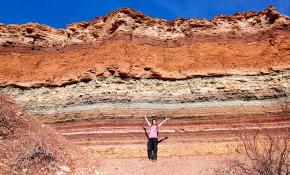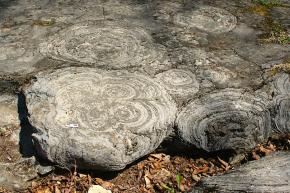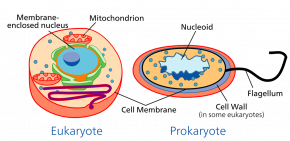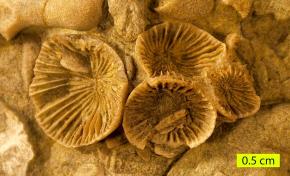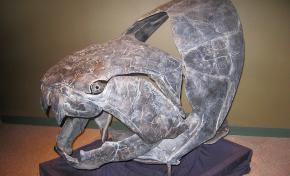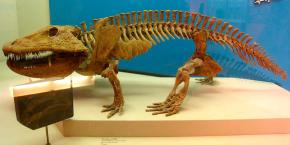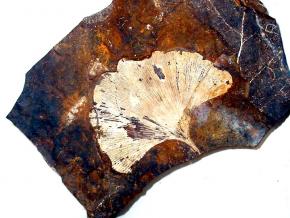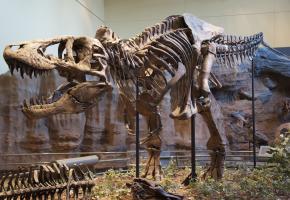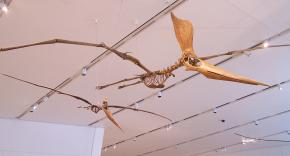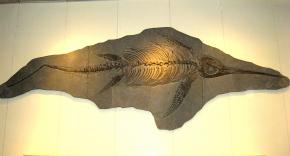Evidence of Earth’s Past
The planet Earth is approximately 4.5 billion years old. Scientists use the geological time scale to describe Earth’s history from its formation to the present day. The time span of 4.5 billion years is divided into smaller segments or units called eons, eras, periods, epochs, and ages (Table 7.2). For example, the entire age of the earth is divided into four eons: the Hadean Eon, the Archean Eon, the Proterozoic Eon, and the Phanerozoic Eon. These four eons are further subdivided into eras (Table 7.3).
Table 7.2. Units within the geological time scale
| Unit |
Time Span |
Size |
| Eon |
0.5 billion years or more (four eons total) |
Largest |
| Era |
several hundred million years (14 eras total) |
|
| Period |
tens to several hundred of million years |
|
| Epoch |
tens of millions of years |
|
| Age |
millions of years |
Smallest |
Fig. 7.7. Distinct layers of rock and sediment deposited over millions of years can be seen at Valle CalchaquГ Valley, Argentina. The layers closest to the surface are the youngest in age. The lowest layers date to approximately 65 million years ago, around the time of the extinction of large dinosaurs.
Image courtesy of travelwayoflife, Flickr
The earth’s crust is composed of many layers of sediment piled on top of each other over time. These horizontal layers are called rock strata and can be seen in canyons and rocky cliffs all over the world (Fig. 7.7). Geological time units are based on obvious, sequential changes in the layers of Earth’s rocks. The Law of Superposition in geology states that layers of sediment and rock are deposited over time in sequence with the oldest layers on the bottom and the youngest layers on top. For example, a fossil found in a lowest rock stratum would likely be much older than fossils found in higher strata.
Because the different geological time units are named for specific rock strata patterns and prominent features, they vary in time spans. For example, the Silurian and Ordovician are both geological periods in the Paleozoic Era, but the Silurian Period spanned 443 million years while the Ordovician Period lasted only 45 million years.
Table 7.3. Geologic record showing eons, eras, and periods
|
|
The Beginning of Earth’s History
Scientists use evidence both from Earth as well as from other objects in our solar system to understand the beginnings of Earth. The best data currently available has led scientists to estimate that our solar system, including the earth, formed approximately 4.5 billion years ago (bya). The earth formed when meteorites collided and stuck to one another, gradually forming a planet. The oldest known Earth mineral has been dated to 4.4 billion years old. The oldest moon rock is approximately 4.5 billion years old. The moon is less geologically active than earth, and thus has rocks that are older. The ages of several meteorites, which have the least geologic activity, have been calculated to be between 4.4 and 4.6 billion years old.
The Beginning of Life on Earth
To understand the ocean floor scientists examine both geological and biological history. One of the methods used by scientists to observe the change of Earth over time is the study of life in the fossil record. The fossil record shows that life on Earth has grown increasingly complex over time. Studying this increase in complexity in the fossil record gives clues about the timing of the changes we can observe in the ocean floor. Although scientists do not know exactly how life first arose on Earth, there is evidence that primitive single-celled organisms called prokaryotes first appeared between 3.8 and 3.5 billion years ago (bya). Modern-day bacteria are related to these ancient prokaryotic microbes. The appearance of similarly aged fossils of the same species on different continents helps scientists study how the Earth’s tectonic plates have moved over time, including the ocean floor.
For more detail on prokaryotes, see What is Alive?
For more detail on the origins of life on Earth, see Building Blocks of Life.
Fig. 7.8. (A) Stromatolites at Lester Park, Saratoga Springs, New York. The white bar represents 3 cm
Fig. 7.8. (B) Stromatolites at Hamelin Pool Marine Nature Reserve, Shark Bay, Australia
Around 3.4 bya, cyanobacteria became widespread on Earth, growing in dense microbial mats in shallow coastal waters. Cyanobacteria are microbial organisms that can produce their own food through photosynthesis, in a process roughly similar to modern plants. The oldest fossilized layers of these cyanobacteria—called stromatolites (fossilized microbial mats, Fig. 7.8)—date back to 3.5 bya.
The Beginning of Complex Life on Earth
Prokaryotic bacteria were the only life on Earth for at least 2 billion years—almost half of the age of the planet (Fig. 7.9). More complex organisms called eukaryotes first appeared in the fossil record around 2.1 to 1.8 bya. Eukaryotes are organisms that have cells containing a nucleus and other structures enclosed within membranes (Fig. 7.10). All living organisms other than bacteria are eukaryotes. Some eukaryotic species, such as protists, live as single-celled organisms. All true multicellular life—organisms comprised of many different living cells—are eukaryotes. These include algae, plants, fungi, and animals.
Fig. 7.9. Timeline of life on Earth in years, drawn to scale
Fig. 7.10. Comparison of prokaryotic and eukaryotic cells (not to scale)
Image courtesy of National Center for Biotechnology Information, Wikimedia Commons, modified by Fan Yang
The first multicellular eukaryotic life appeared in the fossil record between 2 and 0.6 bya (600 million years ago). Single-celled organisms can live in close colonies or even form filaments or microbial mats like cyanobacteria (Fig. 7.8). However, the first multicellular organisms could develop specialized tissues or groups of cells with specific properties and tasks. For example, a plant might have root tissue with cells very different from the cells in its leaf tissue. The arrival of multicellularity led to the relatively rapid evolution of new forms of life. The fossil record in Earth’s layers show how, over time, complex life has evolved.
The Cambrian Explosion and Extinction
The Cambrian explosion is the name of the event marking the rapid diversification of many new groups of multicellular organisms from a single common ancestor. The term “explosion” in this case does not refer to an asteroid impact, volcanic eruption, or violent earthquake, rather it refers to the sudden appearance of many new complex organisms in the fossil record. In geological terms, “rapid” and “sudden” can mean a few million years. The Cambrian explosion began around 542 million years ago and continued for another 20 million years. This event marked a major turning point in the evolution of life on Earth, particularly for animals. Before the Cambrian explosion (known as “precambrian” time), life on the planet mostly consisted of single-celled microbes and some relatively simple, soft-bodied multicellular organisms. After the Cambrian explosion, many new types of complex multicellular organisms and most major groups of animals began to appear in the fossil record (Fig. 7.11).
The time that followed the Cambrian explosion is divided into three geological eras: Paleozoic, Mesozoic, and Cenozoic.
Fig. 7.11. (A) Fossilized skeleton of the extinct coral Streptelasma divaricans is an example of paleozoic life after the Cambrian explosion.
Fig. 7.11. (B) Artist rendering of the 10-m long prehistoric armored fish Dunkleosteus , which lived in the Paleozoic era.
Fig. 7.11. (C) Fossilized Paradoxides trilobite, a diverse group of marine arthropods that went extinct at the end of the Paleozoic era.
Fig. 7.11. (D) Fossil skeleton of Eryops, an extinct amphibian that lived around 295 mya in the late Paleozoic era.
The Paleozoic era spanned from 540 to 252 million years ago (mya) and represents the first era of diverse, complex life on Earth. The name Paleozoic means “ancient life.” During the early Paleozoic era, many new groups of marine invertebrates (animals without backbones) dominated the earth, although primitive vertebrates (animals with backbones) also began to appear. As the Cambrian explosion continued, almost all of the major groups of modern animals evolved from shared common ancestors. The ancient world ocean brimmed with invertebrate animals such as sponges, corals, and crabs (Fig. 7.11 A) as well as the first vertebrate animals: fishes (Fig. 7.11 B). The first animals to begin to colonize dry land were likely arthropods (Fig. 7.11 C). Arthropods are a group of invertebrate animals with jointed arms and hard shells including crabs, shrimp, spiders, and insects. By the end of the Paleozoic era—almost 300 mya after the Cambrian explosion—arthropods, amphibians, and some primitive reptiles dominated the terrestrial environment (Fig. 7.11 D). The Paleozoic era came to a sudden end around 252 mya with the single largest extinction event in Earth’s history.
The Permian-Triassic extinction event—also known as “the great dying”—saw the sudden disappearance of 80 to 96 percent of all marine species and almost 70 percent of all land vertebrate species around 252 mya. The cause of this extinction event remains unresolved, however scientists have proposed several possible scenarios including asteroid impacts and catastrophic volcanic events. This extinction event is one of many throughout the history of life on Earth.
The Age of Reptiles
The Mesozoic era or “age of reptiles” began 252 mya at the end of the Paleozoic era and continued until 66 mya. The land was covered with non-flowering gymnosperm plants, the ancestors of modern-day conifer trees (commonly known as evergreen or pine trees). The tree species Ginkgo biloba evolved during the Mesozoic era and survives to this day (Fig. 7.12 A). It was also during this time that scaly-skinned reptiles replaced amphibians as the dominant vertebrate animals on land. Reptiles are a large and diverse group of vertebrate animals. Most of the reptile groups that lived in the Mesozoic era are extinct today. The best-known extinct reptile group is the dinosaurs. Dinosaurs represent a diverse group of reptiles with many different sizes and shapes (Fig. 7.12 A-C). Dinosaurs and other reptile groups such as flying pterosaurs (Fig. 7.12 B) and swimming ichthyosaurs (Fig 7.12 C) were the dominant vertebrate animals on Earth for almost 200 million years during the Mesozoic era. Despite depictions in popular Hollywood films, Tyrannosaurus rex would never have dined on a Stegosaurus or Brachiosaurus (Fig. 7.12 D). Those dinosaur species were extinct long before the evolution of T. rex.
Fig. 7.12. (A) Fossil leaf of Ginkgo biloba, a tree species that was alive in the Mesozoic era and has survived to present day.
Image courtesy of Dr. Anders Sandberg, Flickr
Fig. 7.12. (B) Replica fossil skeleton of Tyrannosaurus rex, a dinosaur from the Mesozoic era.
Fig. 7.12. (C) Replica fossil skeletons of Geosternbergia sp., a flying pterosaur related to dinosaurs.
Image courtesy of Kenn Chaplin, Flickr
Fig. 7.12. (D) Fossil skeleton of Eurhinosaurus sp., a 6.4 m long swimming ichthyosaur.
The Mesozoic era and the long reign of the dinosaurs ended around 66 mya with another dramatic mass extinction in which most of the dinosaurs were wiped out. The extinction of the dominant dinosaurs cleared the way for a previously obscure group to flourish: the mammals.
The Age of Mammals
The Cenozoic era has been called the “age of mammals”, because it was during this era that mammals became the dominant vertebrate animals on land. This geological era spans from 66 mya to the present day. The human species is an example of a Cenozoic era mammal species.
Although the ancestors of early mammals first evolved in the late Paleozoic era and coexisted with dinosaurs during the Mesozoic era, this group did not flourish until the Cenozoic era that began 66 mya. During the Cenozoic era, mammals became much more diverse, from small shrews, rodents, and bats to large bears, whales, and apes (Fig. 7.13).
Fig. 7.13. (A) Artist sketch of the extinct species Procynosuchus delaharpeae, an early ancestor of modern mammals that lived during the late Paleozoic era.
Fig. 7.13. (B) Artist sketch of Oligokyphus, an extinct primitive mammal that lived during the mid-Mesozoic era.
Fig. 7.13. (C) Fossilized skeleton of the extinct saber-toothed cat Smilodon fatalis from the late Cenozoic era.
During the late Cenozoic era, around two million years ago, the first early human species evolved from an ape ancestral species. Anatomically modern humans (Homo sapiens) first appeared in the fossil record around 200,000 years ago. All of known human history falls within the previous 10,000 years—a very short time compared to the rest of the geological timescale (Table 7.2).
The earth has changed a great deal over its long 4.5 billion year history. It has gone from a molten ball of elements to a layered rocky planet. Following the emergence of plants, an atmosphere rich in oxygen, supporting a lush green world, has replaced Earth’s early atmosphere of methane and carbon dioxide. The history of life on Earth, from microscopic bacteria to enormous whales, reflects the many changes the planet has undergone.
Activity
Develop a model to illustrate the timeline of Earth’s geological and evolutionary history.
Mass Extinctions
The fossil record provides strong and abundant evidence of several mass extinctions of throughout the history of the planet. These extinction events indicate sudden, catastrophic changes on Earth. For example, the boundary between Paleozoic and Mesozoic eras (between Permian and Triassic periods) is marked by the extinction of over 90 percent of all species living at the time. This Permian-Triassic extinction event is the single largest loss of biodiversity in Earth’s history. Similarly, the end of the age of reptiles and dinosaurs was marked by the Cretaceous-Paleogene extinction event around 66 mya.
Scientists have long sought evidence of the causes of these mass extinctions. It is hypothesized that an asteroid impacting Earth caused the decline of the dinosaurs during the Cretaceous-Paleogene extinction. This hypothesis is supported by evidence from ancient craters, rocks enriched with rare minerals found only in meteorites, and rock formations indicative of major impact. Other evidence shows that major volcanic eruptions, glaciers, or the movement of landmasses caused other mass extinctions.
